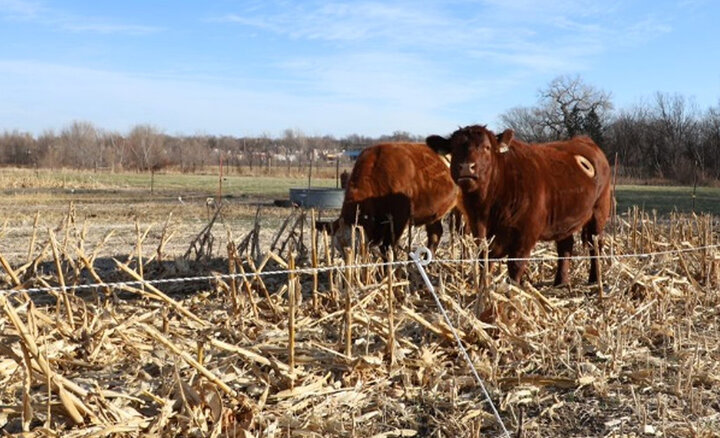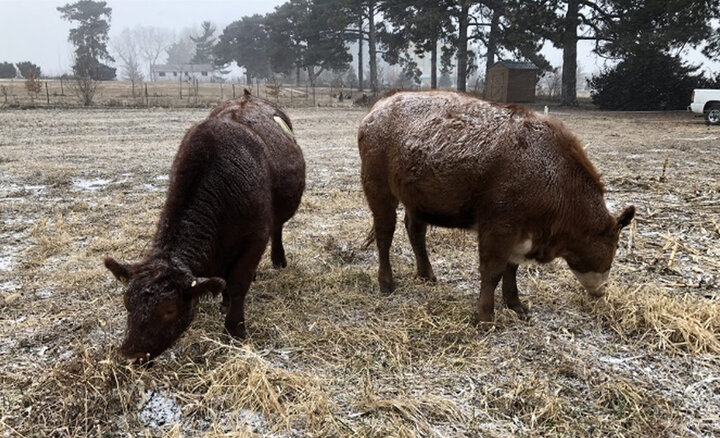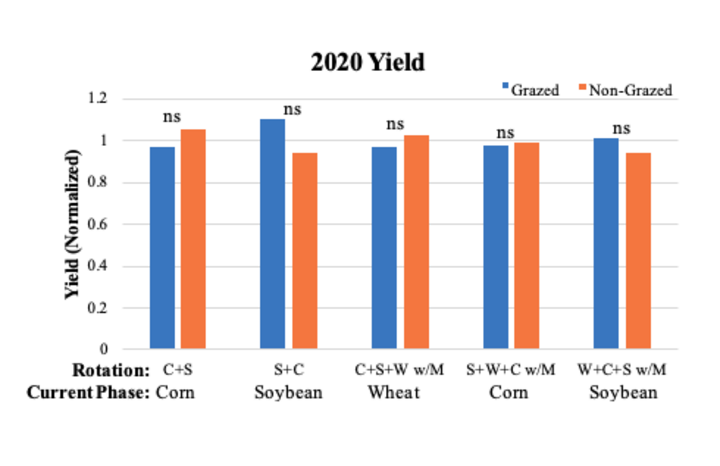Major Findings
Grazing corn residue and cover crops in corn-soybean and corn-soybean-wheat rotations does not affect grain production or soil properties in the short-term (one to two years).
Livestock Integration
Integrated crop and livestock systems have the potential to diversify income streams, add a food production source outside of cash crops and increase nutrient cycling and organic matter within cropland. Together, this type of management can generate increased net return, cropland productivity and resource conservation. (Allen et al., 2007, Kumar et al., 2019).
To evaluate these effects, an experiment was conducted in eastern Nebraska to determine how integrating cattle and cover crops into cropping rotations affects their productivity by evaluating grain yield, soil bulk density, penetration resistance and soil water infiltration rate.
What Did We Do?
We evaluated two no-till, non-irrigated cropping systems from 2018 to 2020 to compare the effects of livestock grazing in a corn-soybean and corn-soybean-wheat rotation. Each crop sequence was present in each year of the experiment. For example, both corn and soybean were grown for the corn-soybean rotation (corn-soybean, soybean-corn) and corn, soybean and wheat were grown for the corn-soybean-wheat rotation (corn-soybean-wheat, soybean-wheat-corn, and wheat-corn-soybean).


In the corn-soybean rotation, corn residue was grazed during the fall/winter using beef stocker steers. The corn-soybean-wheat rotation included an oat cover crop planted in late summer following wheat harvest. For this rotation, both the oat cover crop and corn residue were grazed (Figure 1A-B). Manure was applied one to two months prior to corn planting to the oat stubble. Soybean residue was not grazed in this study.
What Did We Learn?
Crop Response: Grain Yield
In the first production season after grazing (2019), grazing the corn residue and oat cover crop did not affect subsequent soybean or corn grain production in either crop rotation (Figure 2). In 2019, plots with wheat had not yet been grazed due to the phase within the rotation. In 2019, corn averaged 136 bushels/acre and soybean averaged 64 bushels/acre.


Results were similar for the second production season following grazing (2020). In 2020, average yields were 147, 92 and 68 bushels/acre for corn, soybean and wheat, respectively (Figure 3).
This study was managed for typical dryland conditions in eastern Nebraska, and not necessarily for maximum yield. Target plant populations for corn, soybean and wheat were 30,000, 130,000 and 1,500,000 seed per acre, respectively. Nitrogen fertilizer was applied at a rate of 130 lbs. N per acre.
For the corn-soybean-wheat rotation, corn residue was grazed the winter following corn harvest, with soybean planted and harvested the following year. Following soybean, wheat was planted in October and harvested the following July. The oat cover crop was planted in August and grazed after a killing frost during winter. Thus, soybean yield served as an immediate indicator of livestock grazing effects on corn residue. Similarly, corn grain yield would serve as an indicator of livestock grazing effects on the oat cover crop. Wheat yield did not show residual corn residue livestock grazing effects, which would have been from two years prior. Within each year, soybean yield was not affected by livestock grazing corn residue the previous year and corn yield was not affected by livestock grazing the oat cover crop the previous year.
Soil Response: Soil Bulk Density, Soil Penetration Resistance and Soil Water Infiltration
Grazing corn residue in either a corn-soybean rotation or corn-soybean-wheat rotation did not negatively affect soil bulk density, soil penetration resistance or initial soil water infiltration rate. Like grazed corn residue, grazing the oat cover crop following the wheat phase in the corn-soybean-wheat rotation did not increase soil penetration resistance or initial soil water infiltration rate. However, grazing the oat cover crop following the wheat phase in a corn-soybean-wheat rotation did increase soil bulk density (1.43 ± 0.04 vs 1.38 ± 0.04 Mg/m-3) during the first year (2019) of a six-year study (Table 1). It is important to point out that this increase remained below soil bulk density values that negatively affect root growth (Bengough et al., 2011; Rakkar and Blanco-Canqui, 2018).
The results from grain production, grazing corn residue and cover crops generally had no negative impacts on soil compaction during the first two years of the study.
| Treatment | Bulk Density (Mg/m3 | Penetration resistance (MPa) | Initial infiltration rate (cm/sec1/2) | |||
|---|---|---|---|---|---|---|
| Corn residue | Oat cover crop | Corn residue | Oat cover crop | Corn residue | Oat cover crop | |
| Grazed | 1.41±0.04 ns | 1.43±0.04 a | 0.80±0.13 ns | 1.26±0.14 ns | 14.37±4.04 ns | 7.79±2.10 ns |
| Not Grazed | 1.36±0.05 | 1.38±0.04 b | 0.80±0.14 | 1.06±0.07 | 12.75±3.01 | 9.15±3.84 |
Why is this Important?
Livestock grazing corn residue and cover crops did not affect grain yield or soil compaction properties in either a corn-soybean or corn-soybean-wheat rotation. While there was a small increase in bulk density in the first year after oat cover crop grazing, it was not excessive enough to limit root growth and did not reduce subsequent corn grain yields. Based on this research in eastern Nebraska, cattle can be integrated into croplands for grazing to increase diversity and potentially increase the sustainability and resiliency of these systems without reducing crop production.
The western Corn Belt has historically been comprised of corn, soybean and wheat cropping systems. Cattle were integrated into these systems if there were grasslands nearby available for grazing. From 2006 through 2011, more than one million acres of perennial grasslands have been converted to annual row crops in the western Corn Belt, which has reduced livestock numbers and further increased vulnerability of lands that were already prone to drought stress and erosion (Wright & Wimberly, 2013).
As crop production becomes more streamlined and reliant on simplified cropping systems, there are growing concerns about crop productivity, water and nutrient use, soil function, environmental sustainability and climate extremes. A management strategy that can be used to increase resiliency and adaptation of cropping systems is through creating more diversity, which can be accomplished through re-integrating crops and livestock into diversified farming systems (Wright & Wimberly, 2013; Walthall, 2013; Allen et al., 2007; Franzluebbers et al., 2014; Sulc & Tracy, 2007).
References
Allen, V. G., Baker, M. T., Segarra, E., & Brown, C. P. (2007). Integrated Irrigated Crop–Livestock Systems in Dry Climates. Agronomy Journal, 99(2), 346–360. https://doi.org/10.2134/agronj2006.0148
Bengough, G., McKenzie, B. M., Hallett, P. D., and Valentine, T. A. 2011. Root elongation, water stress, and mechanical impedance: A review of limiting stresses and beneficial root tip traits. Journal of Experimental Botany, 62, 59–68. https://doi.org/10.1093/jxb/erq350
Franzluebbers, A. J., Lemaire, G., de Faccio Carvalho, P. C., Sulc, R. M., & Dedieu, B. (2014). Toward agricultural sustainability through integrated crop-livestock systems: Environmental outcomes. Agriculture, Ecosystems & Environment, 190, 1–3. https://doi.org/10.1016/j.agee.2014.04.028
Kumar, S., Sieverding, H., Lai, L., Thandiwe, N., Wienhold, B., Redfearn, D., Archer, D., Ussiri, D., Faust, D., Landblom, D., Grings, E., Stone, J. J., Jacquet, J., Pokharel, K., Liebig, M., Schmer, M., Sexton, P., Mitchell, R., Smalley, S., Jin, V. (2019). Facilitating Crop–Livestock Reintegration in the Northern Great Plains. Agronomy Journal, 111(5), 2141–2156. https://doi.org/10.2134/agronj2018.07.0441
Rakkar, M. K. and Blanco-Canqui, H. 2018. Grazing of crop residues: Impacts on soils and crop production. Agric., Ecosyst. and Environ. 258: 71-90. https://doi.org/10.1016/j.agee.2017.11.018
Sulc, R. M., & Tracy, B. F. (2007). Integrated Crop–Livestock Systems in the U.S. Corn Belt. Agronomy Journal, 99(2), 335–345. https://doi.org/10.2134/agronj2006.0086
Walthall, C., Anderson, C., Baumgard, L., Takle, E., Wright-Morton, L., & al, et. (2013). Climate Change and Agriculture in the United States: Effects and Adaptation. Geological and Atmospheric Sciences Reports. https://lib.dr.iastate.edu/ge_at_reports/1
Wright, C. K., & Wimberly, M. C. (2013). Recent land use change in the Western Corn Belt threatens grasslands and wetlands. Proceedings of the National Academy of Sciences, 110(10), 4134–4139. https://doi.org/10.1073/pnas.1215404110
